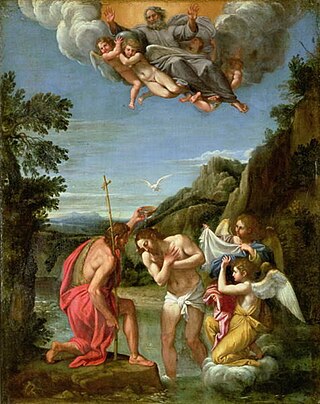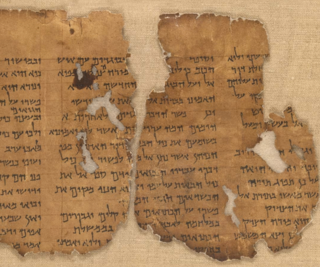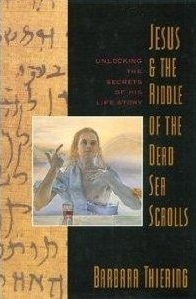Related Research Articles

Adoptionism, also called dynamic monarchianism, is an early Christian nontrinitarian theological doctrine, subsequently revived in various forms, which holds that Jesus was adopted as the Son of God at his baptism, his resurrection, or his ascension. How common adoptionist views were among early Christians is debated, but it appears to have been most popular in the first, second, and third centuries. Some scholars see adoptionism as the belief of the earliest followers of Jesus, based on the epistles of Paul and other early literature. However, adoptionist views sharply declined in prominence in the fourth and fifth centuries, as Church leaders condemned it as a heresy.
The Essenes or Essenians were a mystic Jewish sect during the Second Temple period that flourished from the 2nd century BCE to the 1st century CE.

The resurrection of Jesus is the Christian event that God raised Jesus from the dead on the third day after his crucifixion, starting – or restoring – his exalted life as Christ and Lord. According to the New Testament writing, Jesus was firstborn from the dead, ushering in the Kingdom of God. He appeared to his disciples, calling the apostles to the Great Commission of forgiving sin and baptizing repenters, and ascended to Heaven.

The Dead Sea Scrolls, also called the Qumran Caves Scrolls, are a set of ancient Jewish manuscripts from the Second Temple period. They were discovered over a period of 10 years, between 1946 and 1956, at the Qumran Caves near Ein Feshkha in the West Bank, on the northern shore of the Dead Sea. Dating from the 3rd century BCE to the 1st century CE, the Dead Sea Scrolls include the oldest surviving manuscripts of entire books later included in the biblical canons, including deuterocanonical manuscripts from late Second Temple Judaism and extrabiblical books. At the same time, they cast new light on the emergence of Christianity and of Rabbinic Judaism. Almost all of the 15,000 scrolls and scroll fragments are held in the Shrine of the Book at the Israel Museum located in Jerusalem. The Israeli government's custody of the Dead Sea Scrolls is disputed by Jordan and the Palestinian Authority on territorial, legal, and humanitarian grounds—they were mostly discovered following the Jordanian annexation of the West Bank and were acquired by Israel after Jordan lost the 1967 Arab–Israeli War—whilst Israel's claims are primarily based on historical and religious grounds, given their significance in Jewish history and in the heritage of Judaism.
Ebionites as a term refers to a Jewish Christian sect that existed during the early centuries of the Common Era.

Pauline Christianity or Pauline theology, otherwise referred to as Gentile Christianity, is the theology and form of Christianity which developed from the beliefs and doctrines espoused by the Hellenistic-Jewish Apostle Paul through his writings and those New Testament writings traditionally attributed to him. Paul's beliefs had some overlap with Jewish Christianity, but they deviated from this Jewish Christianity in their emphasis on inclusion of the Gentiles into God's New Covenant and in his rejection of circumcision as an unnecessary token of upholding the Mosaic Law.
Jewish Christians were the followers of a Jewish religious sect that emerged in Judea during the late Second Temple period. These Jews believed that Jesus was the prophesied Messiah and they continued their adherence to Jewish law. Jewish Christianity is the foundation of Early Christianity, which later developed into Catholic, Eastern Orthodox, and Oriental Orthodox Christianity. Christianity started with Jewish eschatological expectations, and it developed into the worship of Jesus as the result of his earthly ministry, his crucifixion, and the post-crucifixion experiences of his followers. Modern scholars are engaged in an ongoing debate about the proper designation of Jesus' first followers. Many modern scholars believe that the term Jewish Christians is anachronistic given the fact that there is no consensus about the date of the birth of Christianity. Some modern scholars have suggested that the designations "Jewish believers in Jesus" and "Jewish followers of Jesus" better reflect the original context.

Most scholars who study the historical Jesus and early Christianity believe that the canonical gospels and the life of Jesus must be viewed within their historical and cultural context, rather than purely in terms of Christian orthodoxy. They look at Second Temple Judaism, the tensions, trends, and changes in the region under the influence of Hellenism and the Roman occupation, and the Jewish factions of the time, seeing Jesus as a Jew in this environment; and the written New Testament as arising from a period of oral gospel traditions after his death.

Géza Vermes, was a British academic, Biblical scholar, and Judaist of Jewish–Hungarian descent—one who also served as a Roman Catholic priest in his youth—and scholar specialized in the field of the history of religion, particularly ancient Judaism and early Christianity. He is best known for his complete translation of the Dead Sea Scrolls into English; his research focused on the Dead Sea Scrolls and other Ancient Hebrew writings in Aramaic such as the Targumim, and on the life and religion of Jesus. Vermes was one of the most important voices in contemporary Jesus research, and he has been described as the greatest Jesus scholar of his time. Vermes' written work on Jesus focuses principally on the Jewishness of the historical Jesus, as seen in the broader context of the narrative scope of Jewish history and theology, while questioning and challenging the basis of the Christian doctrine on Jesus.
Barbara Elizabeth Thiering was an Australian historian, theologian, and biblical exegete specialising in the origins of the early Christian Church. In books and journal articles, she challenged Christian orthodoxy, espousing the view that new findings present alternative answers to its supernaturalistic beliefs. Her analysis has been widely rejected by New Testament scholars and scholars in Judaism.

Robert Eisenman is an American biblical scholar, historian, archaeologist, and poet. He is currently professor of Middle East religions, archaeology, and Islamic law and director of the Institute for the Study of Judaeo-Christian Origins at California State University Long Beach.

The Dead Sea Scrolls Deception is a book by authors Michael Baigent and Richard Leigh. Rejecting the established scholarly consensus that the Dead Sea scrolls were the work of a marginal Jewish apocalyptic movement, and following primarily the thesis of Robert Eisenman, the authors argue that the scrolls were the work of Jewish zealots who had much in common with, and may have been identical to, the early followers of Jesus led by his brother James the Just. Their unconventional hypothesis provides a different version of the history of early Christianity and challenges the divinity of Jesus.

The Teacher of Righteousness is a mysterious figure found in some of the Dead Sea Scrolls at Qumran, most prominently in the Damascus Document (CD), which speaks briefly of the origins of the sect, 390 years after the Neo-Babylonian Empire captured Jerusalem in 586 BCE. After another 20 years of study and waiting, "God... raised for them a Teacher of Righteousness to guide them in the way of His heart".
Alvar Ellegård was a Swedish linguist and scholar. He was professor of English at the University of Gothenburg, and a member of the academic board of the Swedish National Encyclopedia.

The Habakkuk Commentary or Pesher Habakkuk, labelled 1QpHab, was among the original seven Dead Sea Scrolls discovered in 1947 and published in 1951. Due to its early discovery and rapid publication, as well as its relatively pristine preservation, 1QpHab is one of the most frequently researched and analyzed scrolls of the several hundred now known.

Wicked Priest is a sobriquet used in the Dead Sea Scrolls pesharim, four times in the Habakkuk Commentary (1QpHab) and once in the Commentary on Psalm 37 (4QpPsa), to refer to an opponent of the "Teacher of Righteousness." It has been suggested that the phrase is a pun on "ha-kōhēn hā-rōš", as meaning "the High Priest", but this term for the High Priest was obsolete at the time. He is generally identified with a Hasmonean (Maccabean) High Priest or Priests. However, his exact identification remains controversial, and has been called "one of the knottiest problems connected with the Dead Sea Scrolls."

Jesus the Man: New Interpretations from the Dead Sea Scrolls is a book written by the Australian biblical scholar and theologian Barbara Thiering. It was first published by Doubleday in 1992 with the title, Jesus & The Riddle of The Dead Sea Scrolls: Unlocking The Secrets of His Life Story.

Who Wrote the Dead Sea Scrolls? The Search for the Secret Of Qumran is a book by Norman Golb which intensifies the debate over the origins of the Dead Sea Scrolls, furthering the opinion that the scrolls were not the work of the Essenes, as other scholars claim, but written in Jerusalem and moved to Qumran in anticipation of the Roman siege in 70 AD.

The Dead Sea Scrolls and the Christian myth is a 1979 book about the Dead Sea Scrolls, Essenes and early Christianity that proposes the non-existence of Jesus Christ. It was written by John Marco Allegro (1922–1988).

Christian Beginnings from Nazareth to Nicea, AD 30-325 is a 2012 book by the historian Geza Vermes, Professor of Jewish Studies at the University of Oxford, which traces the development of the figure of Jesus from charismatic Jewish prophet to being considered equal with God by the fourth century Council of Nicea. It follows his earlier works on Jesus the Jew.
References
- John Painter, Just James: The Brother of Jesus in History and Tradition (1999), ISBN 1-57003-174-6.
- Sheila E. McGinn, review of Painter (1999), Journal of Early Christian Studies 9.2 (2001) 290–291.